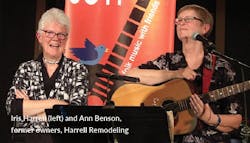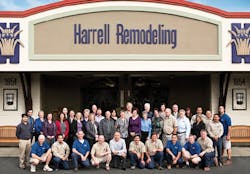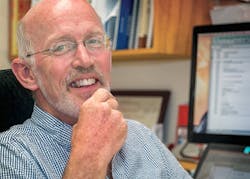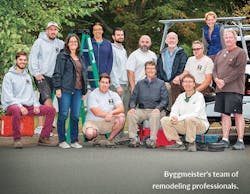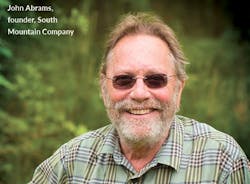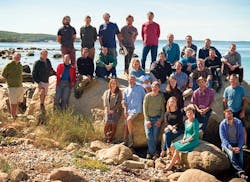Passing the Baton: ESOPs as an Exit Strategy
Successful business owners must inevitably grapple with what to do when the time comes to retire. This predicament becomes even more daunting when the business has a long record of success, significant goodwill from clients, and dedicated employees. One solution is to transfer company ownership to the staff. There are a variety of business models for accomplishing this, but the most well-known is an employee stock ownership plan, or ESOP. An ESOP is a tax-beneficial exit vehicle that’s extremely flexible, allowing the owner to leave the firm within a pliable timeline. According to The ESOP Association, approximately 10,000 ESOPs are in place throughout the U.S., covering 10.3 million employees.
Here, we present three case studies of remodelers who, using very different structures, have transitioned into employee-owned models. We look at what went well and what areas needed adjustment. But first, a few words about ESOPs overall.
What Is an ESOP?
Basically, an ESOP is part retirement plan/part financial instrument that permits privately owned companies to convert the firm’s value into company stock. Over the years, employees can acquire more and more shares of the company, in many cases without laying out a dime.
Typically, shares are awarded based on seniority, management level, and the overall profitability of the company. However, shares can also be purchased by employees as part of their pay or given out as a bonus. Over time, as the company continues to grow and become more profitable, employee-owned shares similarly become more valuable.
By law, contributing employees are 20 percent vested after two years and 100 percent vested within six years. As the ESOP grows and employees become a larger part of the business, owners can slowly distance themselves from the day-to-day responsibilities of being the sole owner.
ESOP shares are held in a trust fund for employees until they retire, at which time the shares are bought back by the company and redistributed. After six years, the employee is fully vested and can take his or her proceeds of the ESOP, along with any company contributions, when either the employee or the company terminates that staff member’s employment.
For owners, this strategy not only provides a way to exit the company, it also prevents the firm from losing its legacy while also giving current and future employees a path to ownership. “When ESOPs started, they were designed for manufacturing firms, but as our economy transitions to being a service-based economy, ESOPs fit really well within industries such as remodeling,” says John Menke, president and CEO of The Menke Group, in San Francisco, one of the nation’s oldest ESOP advisory firms. “I like to say it makes capitalists out of everybody,” he says.
Menke also co-authored the federal Employee Retirement Income Security Act of 1974 (ERISA), which was the first law to recognize ESOPs.
Other Benefits
ESOPs are also a powerful corporate financing tool because current tax laws permit companies to borrow money from outside lenders against existing shares and future earnings in order to finance the purchase of more shares. When the ESOP is leveraged to fund allocations, the company uses profits to repay the loan. All of the profits from the company are either tax deferred or tax exempt, since they are reinvested into the ESOP—a tax-sheltered vehicle. The ability to borrow money against existing shares also creates liquidity for a company that may not be sellable on the open market.
Finally, when an owner retires and cashes in his or her shares, the proceeds are indefinitely tax deferred, providing that at least 30 percent are reinvested into other securities or stocks. The funds remain in the ESOP account until the employee retires or terminates employment. Very rarely can employees borrow against an ESOP account.
Harrell Remodeling
Palo Alto, Calif.; $10 million in annual revenue; 36 employees
- 100 percent employee-owned
- Each employee is fully vested in his or her shares after five years
- Each employee is part of the vesting program after 1,000 hours
- The ESOP is funded through company profits and allows all employees to participate in the vesting process without paying with their own money
Background
Iris Harrell founded Harrell Remodeling in Texas during the early 1980s with her life/business partner, Ann Benson. In 1985, the two moved to California where they opened one of the very first woman-owned remodeling firms in the nation. The firm quickly became synonymous with high-quality work, while also building a reputation of inclusion and respect. “Something wonderful happens when talented people team up and are treated with care and respect,” Harrell says. “They pass that respect and care along to the clients.”
In 2000 Harrell became more focused on succession planning and began studying ESOPs. In 2001, she engaged Anthony Mathews at the Rady School of Management, University of California, San Diego, who is one of the best-known ESOP consultants in the country, to help put their plan into motion. Harrell Remodeling would be 100 percent employee-owned within eight years.
Results
In 2014, Harrell Remodeling celebrated not only Harrell and Benson’s retirement, but also the announcement that the company had achieved its goal of 100 percent ownership. While the original plan was to reach this milestone in eight years, the economic downturn prevented the firm from contributing profits to the ESOP for a time. As a result, in 2013 the ESOP had only reached a 38 percent stake in the company. So, in 2014, the firm leveraged the ESOP in the form of an outside loan in order to make the 100 percent transition work.
Areas of strength: According to Harrell and Ciro Giammona, current CEO of Harrell Remodeling, the company did three things well during the ESOP formation:
- Awareness and education: These areas were critical throughout the fact-finding period. ESOPs are complicated, and talking with other business owners and experts helped Harrell and Giammona to avoid mistakes.
- Excellent consultants: Harrell and Giammona credit their attorneys and accounting firms with their ESOP’s success. These consultants walked the company through every stage of the process and helped develop strict rules and procedures to keep the integrity of the ESOP intact.
- Communication: Because all employees will eventually be owners, Harrell and Giammona felt there needed to be extra emphasis placed on the exchange of information. The two were transparent with the bookkeeping and elevated the knowledge level of the firm.
Areas for improvement: If there were to be one area that Giammona may have changed, it would be the length of time it took for the ESOP to become 100 percent employee-owned. Still, he explains, this stretch of time allowed the management team to mature into their roles. Plus, the recession made ESOP contributions almost impossible.
Byggmeister
Newton, Mass.; $3.3 million in annual revenue; 12 employees
- Founder and owner Paul Eldrenkamp (pictured, above) will sell the company to current employees and management in exchange for five years of his salary
- On May 31, 2024, Eldrenkamp will retire
- Over the next five years, Eldrenkamp will allow the current team to become more engaged in day-to-day tasks
- Employees will not have to purchase shares, but rather will “inherit” the company after five years
Background
Paul Eldrenkamp founded Byggmeister in 1983. The company started out improving homes in the Boston area and in 2000 began focusing on design/build work with an emphasis on energy efficiency. Over time, the 12-person Byggmeister team became a tight-knit group. This was when Eldrenkamp recognized that he wanted to create a company to last through the ages.
“We were doing very interesting jobs and developing a really high level of work using solid building science, metrics, and accountability,” Eldrenkamp says. “It was clear to me that there was a critical mass of knowledge in our firm that was very special. If we dispersed, the collective impact would be diluted.” So, in 2014, Eldrenkamp began to informally shape his plans for an exit strategy and a path toward employee ownership.
Structure
While Eldrenkamp emphasizes that his employee-ownership program isn’t finalized, he has a clear vision for how he will gradually turn over the company to his employees. The highlights for his exit strategy are as follows: Eldrenkamp will sell the company to current employees and management in exchange for five years of his salary as a form of simple employee buyout. On May 31, 2024, Eldrenkamp will retire. The date is significant because it will be his 67th birthday, the last day of the firm’s fiscal year, and a Friday. Over the next five years, Eldrenkamp will perform fewer of his duties as owner and will allow the current team to become more engaged in day-to-day tasks. Employees will not have to purchase shares, but rather will buy the company after five years.
Areas of Strength
Because Eldrenkamp’s retirement and succession planning is still in progress, it’s difficult to fully evaluate its success. However, he has begun to hand off more and more responsibilities to his employees in preparation for his planned exit. One of the things he did was to completely leave the company for six months, releasing the reins of his firm to his employees. When he returned, he was pleased with the way his team had matured and risen to the occasion as fledgling owners, including bringing in $1.2 million in new work.
South Mountain Company
Martha’s Vineyard, Mass.; $12 million in annual revenue; 21 employees
- Restructured into a worker cooperative
- New members pay an ownership fee
- Employees must work five years and 6,000 hours before being eligible for ownership
- Qualified members receive equal ownership, including profits and a role in decision-making
Background
John Abrams and former partner Mitchell Posin founded South Mountain Company (SMC) in 1975 when the two moved to Martha’s Vineyard to design and build one of the firm’s first houses. The project was successful and SMC continued to grow and prosper. Like many young companies, SMC started out as a partnership and then, in 1984, evolved into a sole proprietorship.
In 1986, several employees approached Abrams with an idea. “They told me they wanted to stay at SMC, but they also wanted more than an hourly wage,” he says. That was the impetus for Abrams and his team to create an ownership structure that was democratically centered. After hiring Peter Pitegoff, an attorney with the Industrial Cooperative Association (now The ICA Group), the framework was created for a new ownership structure at the firm. In 1987, the company was converted to a worker cooperative, and today SMC is a design/build renewable-energy firm that includes 21 employee-owners.
One of the biggest differences between a cooperative and an ESOP has to do with decision-making. Generally speaking, an ESOP allows employees to share in the profits of the company but not necessarily in the decision-making. Decisions are made among people who have the most shares, so the more shares you own, the more powerful your position in deciding company policy. In cooperative corporations, however, each owner has an equal vote, regardless of the number of shares owned. Therefore, each cooperative employee-owner shares in not only the company’s profits and losses, but also in the decision-making process.
Structure
As compensation for selling the company to the cooperative, Abrams received preferred shares based on a valuation of the company by Pitegoff. These shares were converted to cash over five years, in addition to a full ownership share. Unlike common stock, preferred-share owners are guaranteed the payment of dividends.
New members must pay an ownership fee. Originally, the firm kept the fee at $3,500, but by 2012 the ownership fee had climbed to $13,000. Members must work five years and 6,000 hours before being eligible to receive an ownership share. Following the five-year initiation period, qualified employees receive full and equal ownership in SMC, including both profits and policy decision-making.


